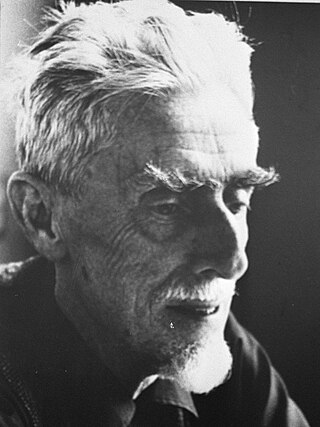
Maurits Cornelis Escher was a Dutch graphic artist who made woodcuts, lithographs, and mezzotints, many of which were inspired by mathematics. Despite wide popular interest, for most of his life Escher was neglected in the art world, even in his native Netherlands. He was 70 before a retrospective exhibition was held. In the late twentieth century, he became more widely appreciated, and in the twenty-first century he has been celebrated in exhibitions around the world.

The Penrose triangle, also known as the Penrose tribar, the impossible tribar, or the impossible triangle, is a triangular impossible object, an optical illusion consisting of an object which can be depicted in a perspective drawing, but cannot exist as a solid object. It was first created by the Swedish artist Oscar Reutersvärd in 1934. Independently from Reutersvärd, the triangle was devised and popularized in the 1950s by psychiatrist Lionel Penrose and his son, prominent Nobel Prize-winning mathematician Sir Roger Penrose, who described it as "impossibility in its purest form". It is featured prominently in the works of artist M. C. Escher, whose earlier depictions of impossible objects partly inspired it.

Hand with Reflecting Sphere, also known as Self-Portrait in Spherical Mirror, is a lithograph by Dutch artist M. C. Escher, first printed in January 1935. The piece depicts a hand holding a reflective sphere. In the reflection, most of the room around Escher can be seen, and the hand holding the sphere is revealed to be Escher's.

Regular Division of the Plane is a series of drawings by the Dutch artist M. C. Escher which began in 1936. These images are based on the principle of tessellation, irregular shapes or combinations of shapes that interlock completely to cover a surface or plane.

Metamorphosis II is a woodcut print by the Dutch artist M. C. Escher. It was created between November, 1939 and March, 1940. The print measures 19.2 by 389.5 centimetres and was printed from 20 blocks on 3 combined sheets. Metamorphosis II is a long, horizontal piece which depicts animals and other forms gradually transforming into each other.

Reptiles is a lithograph print by the Dutch artist M. C. Escher first printed in March 1943. It touches on the theme found in much of his work of mathematics in art.
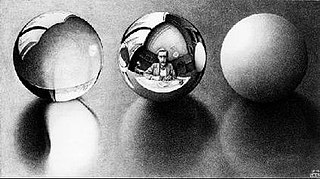
Three Spheres II is a lithograph print by the Dutch artist M. C. Escher first printed in April 1946.
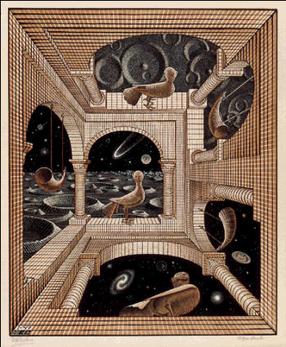
Another World II, also known as Other World II, is a woodcut print by the Dutch artist M. C. Escher first printed in January 1947.

Oscar Reutersvärd was a Swedish graphic artist, who in 1934 pioneered the art of 3D drawings that may initially appear feasible, yet cannot be physically constructed. He is sometimes described as "the father of the impossible figure", although there are much older examples, e.g. Hogarth's Satire on False Perspective.

Metamorphosis III is a woodcut print by the Dutch artist M. C. Escher created during 1967 and 1968. Measuring 19 cm × 680 cm, this is Escher's largest print. It was printed on thirty-three blocks on six combined sheets.

Stars is a wood engraving print created by the Dutch artist M. C. Escher in 1948, depicting two chameleons in a polyhedral cage floating through space.

Drawing Hands is a lithograph by the Dutch artist M. C. Escher first printed in January 1948. It depicts a sheet of paper, out of which two hands rise, in the paradoxical act of drawing one another into existence. This is one of the most obvious examples of Escher's common use of paradox.
Earl Marshawn Washington is an American entrepreneur, printmaker, and engraver.
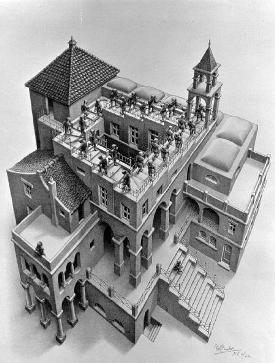
Ascending and Descending is a lithograph print by the Dutch artist M. C. Escher first printed in March 1960. The original print measures 14 in × 11+1⁄4 in. The lithograph depicts a large building roofed by a never-ending staircase. Two lines of identically dressed men appear on the staircase, one line ascending while the other descends. Two figures sit apart from the people on the endless staircase: one in a secluded courtyard, the other on a lower set of stairs. While most two-dimensional artists use relative proportions to create an illusion of depth, Escher here and elsewhere uses conflicting proportions to create the visual paradox.

Tower of Babel is a woodcut print by the Dutch artist M. C. Escher, who created it in 1928, illustrating his early artistic interest in depicting new perspectives and unusual viewpoints in his works.

Sky and Water I is a woodcut print by the Dutch artist M. C. Escher first printed in June 1938. The basis of this print is a regular division of the plane consisting of birds and fish. Both prints have the horizontal series of these elements—fitting into each other like the pieces of a jigsaw puzzle—in the middle, transitional portion of the prints. In this central layer the pictorial elements are equal: birds and fish are alternately foreground or background, depending on whether the eye concentrates on light or dark elements. The birds take on an increasing three-dimensionality in the upward direction, and the fish, in the downward direction. But as the fish progress upward and the birds downward they gradually lose their shapes to become a uniform background of sky and water, respectively.

Mathematics and art are related in a variety of ways. Mathematics has itself been described as an art motivated by beauty. Mathematics can be discerned in arts such as music, dance, painting, architecture, sculpture, and textiles. This article focuses, however, on mathematics in the visual arts.

Print Gallery is a lithograph printed in 1956 by the Dutch artist M. C. Escher. It depicts a man in a gallery viewing a print of a seaport, and among the buildings in the seaport is the very gallery in which he is standing, making use of the Droste effect with visual recursion. The lithograph has attracted discussion in both mathematical and artistic contexts. Escher considered Print Gallery to be among the best of his works.
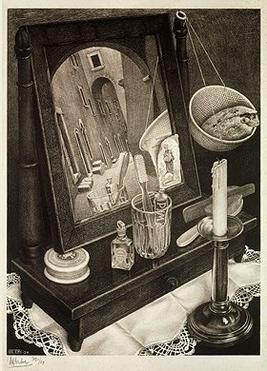
Still Life with Mirror is a lithograph by the Dutch artist M. C. Escher which was created in 1934. The reflection of the mirror mingles together two completely unrelated spaces and introduces the outside world of the small town narrow street in Abruzzi, Villalago, into internal world of the bedroom. This work of Escher is closely related to his later application of mirror effect in 1937 Still Life and Street. Escher manipulates the scale in different parts of the print to achieve the effect of smooth connection between worlds.
Day and Night is a woodcut made by the Dutch artist M. C. Escher in 1938.


















